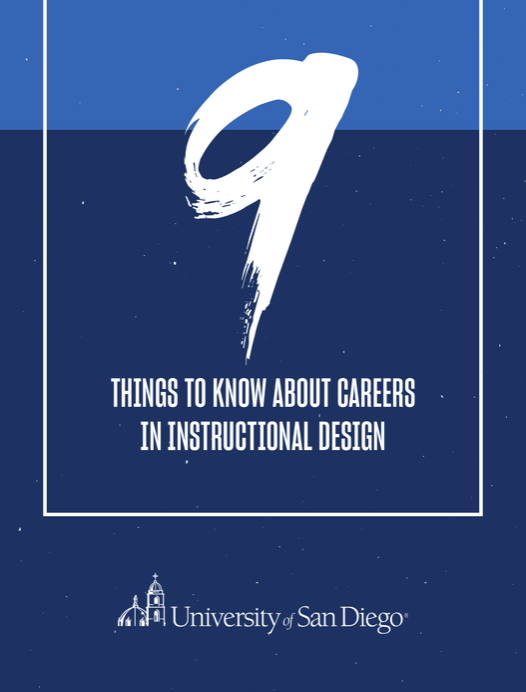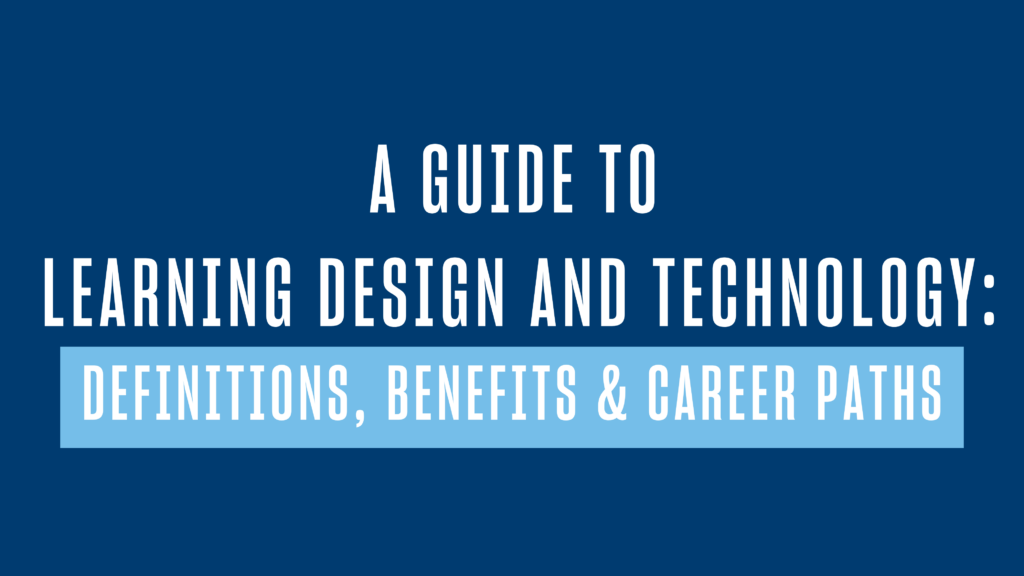The world of education is constantly adapting to the ever-changing needs of learners. In this landscape, instructional design (ID) and learning experience design (LXD) each shape effective and engaging learning experiences. While sometimes considered separately, a closer look reveals how complementary they are.
ID and LXD share common roots, as both focus on understanding the learner’s needs, preferences and motivations. It’s not about drawing lines between these two disciplines but, rather, embracing their interconnectedness.
In this post, we explore the relationship between ID and LXD, dispelling the notion of stark differences and emphasizing their collaborative nature. Whether you are considering a career shift, a seasoned professional in the field or just curious about the subject, this guide will explore the many similarities between ID and LDX.
What Is Instructional Design (ID)?
Instructional design is a systematic process for creating effective learning experiences. This approach involves analyzing learning needs and goals and then developing and implementing experiences that aid learners in achieving those objectives. The focus of ID is not only on the curriculum but also on how instructors are teaching that information.
History
ID is rooted in military training programs from World War II. It found applications in education during the ’50s and ’60s, with influencers such as Robert Gagné leading its evolution. The emergence of the ADDIE model in the late ’60s and ’70s and the growth of computer-based training and eLearning through the ’80s and ’90s brought ID to prominence in the modern educational landscape.
Impact
ID plays a vital role in designing and delivering online courses, ensuring accessibility and leveraging technology. Its systematic approach has shifted educational paradigms from traditional to interactive methods, with its reach spanning various educational sectors, including adult learning programs, corporate training and professional development.
Applications
ID offers tailored solutions to meet various learning needs. Here are a few ways ID may be applied in various settings:
- K–12 Education
ID helps in creating engaging curricula, integrating technology and designing assessments that cater to different learning needs. - Higher Education
At the collegiate level, ID is pivotal in online and blended learning, incorporating multimedia and interactivity to enhance learning. - Corporate Training
In the business world, ID supports the development of specialized training programs, including leadership development and skill-building. - Healthcare Education
ID contributes to medical training by assisting in the creation of simulations and interactive modules.
What Is Learning Experience Design (LXD)?
Learning experience design is a relatively new field making a significant impact in contemporary learning environments. Unlike traditional design methods, LXD prioritizes creating engaging, learner-focused experiences that not only aim to improve learning outcomes but also provide an enjoyable process for the learner. It is an interdisciplinary field that brings together principles from both instructional design and user experience design (UX).
What sets LXD apart is its incorporation of a deep understanding of the learner. By focusing on the needs, preferences and experiences of the individual learner, LXD ensures a more personalized learning experience. This learner-centered approach prioritizes the learner’s experience over other aspects, leading to more engaging and memorable learning.
History
LXD emerged in the early 21st century as a fusion of ID, UX and design thinking. Championed by learning experience designer Niels Floor, LXD grew with the rise of the digital learning era, challenging the traditional one-size-fits-all model and giving birth to a more learner-centric approach to education.
Impact
LXD’s focus on individual learners has significantly impacted contemporary learning environments. Its principles have reshaped educational practices across schools, universities and corporate training, leading to more engaging and resonant learning experiences. LXD’s emphasis on personalization and effectiveness sets it apart as an innovative field in education.
Applications
LXD is applied across various educational contexts, where it has brought fresh perspectives to crafting learning experiences. It’s used in schools, colleges and corporate environments, ensuring that education is not just about transmitting information but also creating meaningful and personalized experiences that resonate with each student. Here are several scenarios in which LXD may be applied:
- K–12 Education
LXD applies human-centered design to create engaging lessons and projects that cater to students’ interests and abilities. - Higher Education
At the university level, LXD focuses on creating interactive and personalized course content that responds to individual learning needs. - Corporate Training
LXD designs tailored training modules in the business sector, focusing on employee growth and development. - Online Learning Platforms
LXD is instrumental in designing user-friendly interfaces and personalized paths in massive open online courses (MOOCs) and other eLearning environments. - Health Care Education
In health care, LXD creates patient education materials that are engaging and easily understandable, helping to enhance health literacy.
5 Overlapping Aspects of Instructional Design and Learning Experience Design
ID and LXD may seem to have different approaches, but they are both central to creating effective learning environments. The distinctions between ID and LXD are subtle and are often complementary, with the two working together to ensure learners receive the best education tailored to their needs. Let’s explore some of the key commonalities between these fields.
Skills
Both ID and LXD practitioners share certain skills that are essential for successful design. The following shared skills underline the focus on the learner and the intention to create engaging and effective learning experiences:
- Needs Analysis
- ID: Focuses on assessing the learning gap and specific objectives for a curriculum or training program
- LXD: Emphasizes understanding the learner’s preferences and experiences to create personalized learning pathways
- Empathy for Learners
- ID: Utilizes empathy to ensure that learning objectives align with the learner’s needs
- LXD: Extends empathy to encompass the entire learning experience, focusing on enjoyment and engagement
- Creative Problem-Solving
- ID: Applies creativity in designing effective learning solutions for complex subjects
- LXD: Uses creative techniques to craft engaging and enjoyable experiences
Methodology
The process and methods used in ID and LXD are similar, with both involving learner analysis and iterative design. This approach emphasizes the shared goal of tailoring educational experiences to the learner’s needs. Whether in the stages of design, development or evaluation, ID and LXD intertwine to create a streamlined, learner-centered approach.
- Learner Analysis
- ID: Conducts thorough analysis to determine learning objectives and content structure
- LXD: Focuses on the learner’s experience, tailoring content to preferences and motivational factors
- Iterative Design
- ID: Utilizes a cyclical process, often using instructional design models such as ADDIE, to design, develop and evaluate learning
- LXD: Emphasizes prototyping to ensure an engaging learner experience
Outcomes
The ultimate goal for both ID and LXD is the creation of engaging and effective learning experiences that meet established objectives and enhance the learner’s understanding and capabilities. Whether through ID’s focus on systematic design or LXD’s emphasis on learner experience, the outcome is a shared dedication to educational excellence.
Both ID and LXD are committed to creating engaging learning experiences, but their focuses vary:
- Engaging Learning Experiences
- ID: Crafts content that is both informative and engaging, often using multimedia elements
- LXD: Prioritizes the learner’s enjoyment and immersion in the experience, using elements such as gamification
- Effective Learning Experiences
- ID: Ensures the learning objectives are met through systematic design
- LXD: Focuses on how effective the experience is for the learner, considering both learning and enjoyment
[RELATED RESOURCE] Want to create meaningful learning content? Explore how instructional design helps learners connect and engage.
Career Paths
In terms of professional opportunities, ID and LXD offer overlapping roles that reflect their inherent connection. The following roles highlight the transferable skills and shared goals of both disciplines.
- Learning and Development Specialist
- ID: Often works in corporate training, focusing on learning goals and objectives
- LXD: More likely to focus on the overall learner experience, incorporating UX design principles
- Instructional Designer
- ID: Primarily concerned with the systematic design of learning experiences
- LXD: Balances systematic design with a strong focus on the learner’s experience and engagement
- eLearning Developer
- ID: Focuses on creating online learning content, often in collaboration with subject matter experts
- LXD: Emphasizes interactive and engaging online experiences, often using advanced design tools
Theories
Both ID and LXD are rooted in shared theoretical foundations, but they apply these principles in different, yet complementary ways. Each approach incorporates the following theories in practice, emphasizing learner-centered strategies and a holistic consideration of the learner.
- Behaviorism
- ID: Focuses on observable behaviors, employing reinforcement techniques such as immediate feedback in computer-based training
- LXD: Emphasizes the reward system through gamification, utilizing badges or points to reinforce learning behaviors
- Both approaches, although implemented differently, leverage behaviorist principles to guide and reinforce learner behavior.
- Cognitivism
- ID: Utilizes cognitive strategies such as structured information processing, chunking and analogies, as seen in eLearning modules incorporating mnemonic devices
- LXD: Tailors the design to the learner’s cognitive load, using microlearning techniques to break down complex topics
- While the methods vary, both ID and LXD value cognitive principles in their approach to design, focusing on how learners process information.
- Constructivism
- ID: Promotes learner engagement and active learning, employing problem-based scenarios to encourage discovery and exploration
- LXD: Creates interactive experiences, such as collaborative learning communities or interactive simulations, enabling learners to build knowledge actively
- These two disciplines both harness constructivist theories but do so in a way that emphasizes different aspects of active learning and knowledge construction.
Instructional design and learning experience design are not separate fields but two interconnected disciplines that are both needed in modern education and training. Together, they contribute to the creation of rich and effective learning experiences, emphasizing the learner’s needs, desires and preferences.
Graduate programs such as the Master of Science in Learning Design and Technology offered by the University of San Diego help prepare students to leave an indelible mark on the future of education. For those interested in learning more about instructional design and how to become a professional in the field, our eBook, 9 Things to Know About Careers in Instructional Design, is a compelling starting point. Download your copy now to learn more.



![Preview image of What is Instructional Design? [5 Examples + Overview]](https://onlinedegrees.sandiego.edu/wp-content/uploads/2021/08/ldt_blog_whatisid-1024x576.png)
![What is Learning Experience Design? [+ Career Paths]](https://onlinedegrees.sandiego.edu/wp-content/uploads/2023/06/ldt_blog_learningexperiencedesign-1024x576.png)
